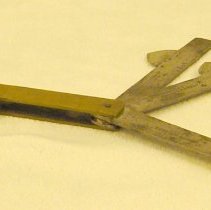All Objects Record
Images

Metadata
Object Name |
Fleam |
Object ID |
2004.110.01.01 |
Date |
/ / |
Earliest Year |
1800 |
Latest Year |
1899 |
Description |
Brass shield and 3 fleams. Each fleam blade has a straight edge with a triangle shaped point on one side near the top. |
Dimensions |
H-0.8 W-2.5 L-8 cm |
Dimension Details |
Cover: 0.75 x 8 x 2.5. Fleams 0.1 x 8 x 2 |
Materials |
Metal/Brass |
Manufacturer |
Manufacturer Label: Joseph Rodgers and Sons, 6 Norfolk St., Sheffeild |
Provenance |
In the early 1920s, the Faculty of Medicine at the University of Western Ontario in London, Ontario, Canada, began accepting medical artifacts for a historical museum. It remained an unofficial collection until it was turned into the Medical Museum and Archives at University Hospital in the 1970s. In the 1990s, many of these artifacts were spread out among various local institutions, and the remaining objects were reorganized into the Medical Artifact Collection at the University of Western Ontario, catalogued and organized by Michelle Hamilton. |
MeSH Search Terms |
Therapeutics Punctures Phlebotomy Bloodletting |
Classification |
Bloodletting Phlebotomy |
Research Notes |
Used for bloodletting, variations of this device have existed since the Middle Ages. The word "fleam" is said to be related to the term "phlebotomy," used to refer to the taking of blood. More often associated with veterinary practice, it was often used on the jugular vein of a farm animal such as a horse, though the same tool was likely used on humans as well. A fleam stick would be used to hit the back of the blade and make the incision as quickly and suddenly as possible. This particular fleam was made by celebrated cutlers Joseph Rodgers and Sons, who made all kinds of knives and cutlery in Sheffield in the UK between the 1700s and into the 20th century. |
